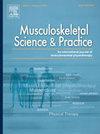The relationship between vestibulo-ocular function and sports injuries in adolescent rugby union players
IF 2.2
3区 医学
Q1 REHABILITATION
引用次数: 0
Abstract
Objectives
Deficits in vestibulo-ocular function have been reported in athletes following concussion and in healthy developing adolescent athletes. There is a known increase in injury risk in athletes returning to sport following concussion; however, the relationship between vestibulo-ocular dysfunction in adolescents and injury risk is unknown. The aim of this study was to determine i) the prevalence of vestibulo-ocular dysfunction and ii) the relationship between vestibulo-ocular dysfunction and playing season injuries in adolescent rugby union players.
Design
Cross-sectional.
Method
Seventy-one male adolescent rugby union players were recruited from four schools in Queensland, Australia. In the preseason, clinical assessments of oculomotor and vestibular function were conducted. ‘Time-loss’ injuries were recorded during the season. Statistical analysis was conducted using Pearson's chi-square test with significance set at p < 0.05.
Results
In preseason assessment, 40 players (57 %) had one or more, and of these, 18 players (25.7 %) had two or more positive vestibular and oculomotor findings indicating vestibulo-ocular dysfunction. There were 39 injuries sustained by 33 players during the season. No between group differences for vestibulo-ocular function were found between players who did and did not sustain an in-season injury (p = 0.55).
Conclusion
Vestibulo-ocular dysfunction is common in male adolescent rugby union players and positive findings should include comparison with baseline function or symptom profile. The wider impact of vestibulo-ocular dysfunction on sporting performance in adolescents is unknown.
青少年橄榄球联盟运动员前庭-眼功能与运动损伤的关系
目的报道了运动员脑震荡后前庭眼功能缺损和健康发育的青少年运动员。众所周知,脑震荡后重返运动的运动员受伤风险增加;然而,青少年前庭-眼功能障碍与损伤风险之间的关系尚不清楚。本研究的目的是确定i)前庭-眼功能障碍的患病率和ii)前庭-眼功能障碍与青少年橄榄球联盟球员赛季损伤之间的关系。方法从澳大利亚昆士兰州的四所学校招募了71名男性青少年橄榄球联盟球员。在季前赛中,进行了眼部运动和前庭功能的临床评估。赛季中出现了“时间损失”伤病。统计学分析采用皮尔逊卡方检验,显著性集为p <;0.05.结果在季前赛评估中,40名球员(57%)有一项或多项前庭和动眼肌运动阳性结果,其中18名球员(25.7%)有两项或两项以上前庭-眼功能障碍。整个赛季共有33名球员受伤39次。在赛季中受伤和没有受伤的球员之间,前庭-眼功能在组间没有差异(p = 0.55)。结论前庭-眼功能障碍在男性青少年橄榄球联盟运动员中很常见,阳性结果应与基线功能或症状进行比较。前庭-眼功能障碍对青少年运动表现的更广泛影响尚不清楚。
本文章由计算机程序翻译,如有差异,请以英文原文为准。
求助全文
约1分钟内获得全文
求助全文
来源期刊

Musculoskeletal Science and Practice
Health Professions-Physical Therapy, Sports Therapy and Rehabilitation
CiteScore
4.10
自引率
8.70%
发文量
152
审稿时长
48 days
期刊介绍:
Musculoskeletal Science & Practice, international journal of musculoskeletal physiotherapy, is a peer-reviewed international journal (previously Manual Therapy), publishing high quality original research, review and Masterclass articles that contribute to improving the clinical understanding of appropriate care processes for musculoskeletal disorders. The journal publishes articles that influence or add to the body of evidence on diagnostic and therapeutic processes, patient centered care, guidelines for musculoskeletal therapeutics and theoretical models that support developments in assessment, diagnosis, clinical reasoning and interventions.
 求助内容:
求助内容: 应助结果提醒方式:
应助结果提醒方式:


